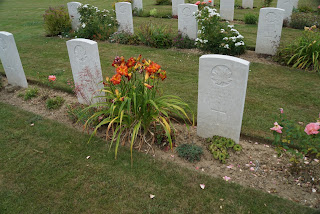Our final visit of our long day was at a Canadian War Cemetery here in Normandy. This was our first visit to a cemetery on the trip. Visits to a German cemetery and (I think) a British cemetery is also on the agenda. Of course, a visit to America's Normandy cemetery takes place on our final full day here.
The visit was surprisingly powerful. The British Commonwealth handled burial of their dead in a different manner from the Americans. The families in Canada, for instance, weren't given the option to repatriate their loved ones' remains. Families could, however, have an inscription made on the tombstone of their soldier. Lauren found these inscriptions particularly moving. Here are a few examples.
There were also some other ways in which the grave markers showed care and nodded to the diversity in Canada's armed forces. Most graves were in English, but quite a few were in French. At first I thought it would just be in English or French given the soldier's unit. However, I did catch two different markers in the two languages for an officer and enlisted grade man in the same unit. Canadians who died in service to the RAF had a different logo emblazoned atop the marker. And the naming protocols of Canadian (and British, for that matter) also brought more individuality to the graves.
One other feature I liked about the cemetery, though concerned the way in which it had the feel of a church. The Canadians maintain more cemeteries than the U.S. does, but each is much smaller and mostly holds bodies near where they were slain. The uniform rows made it obvious that military dead were buried here, but in most other respects it looks like it belonged to some church next door.
The visit was surprisingly powerful. The British Commonwealth handled burial of their dead in a different manner from the Americans. The families in Canada, for instance, weren't given the option to repatriate their loved ones' remains. Families could, however, have an inscription made on the tombstone of their soldier. Lauren found these inscriptions particularly moving. Here are a few examples.
There were also some other ways in which the grave markers showed care and nodded to the diversity in Canada's armed forces. Most graves were in English, but quite a few were in French. At first I thought it would just be in English or French given the soldier's unit. However, I did catch two different markers in the two languages for an officer and enlisted grade man in the same unit. Canadians who died in service to the RAF had a different logo emblazoned atop the marker. And the naming protocols of Canadian (and British, for that matter) also brought more individuality to the graves.
One other feature I liked about the cemetery, though concerned the way in which it had the feel of a church. The Canadians maintain more cemeteries than the U.S. does, but each is much smaller and mostly holds bodies near where they were slain. The uniform rows made it obvious that military dead were buried here, but in most other respects it looks like it belonged to some church next door.







Comments
Post a Comment